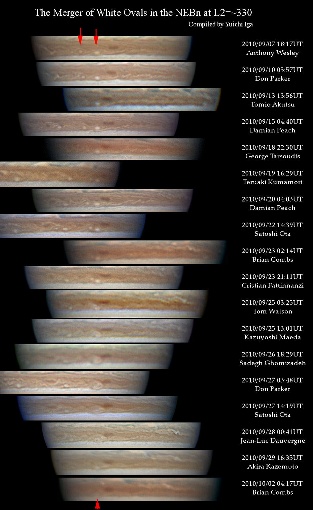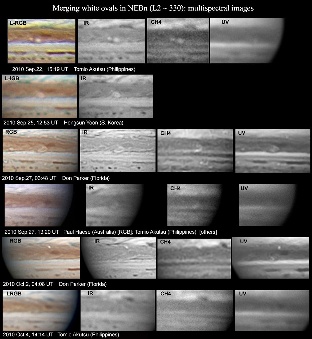

[11] NEBn: Second merger of Anti-cyclonic white ovals.
Jupiter in 2010- Report no.12
NEBn: Second merger of anticyclonic white ovals
(Yuichi Iga & John Rogers, 2010 Oct.12)
A second merger of anticyclonic white ovals in the NEBn occurred in late
September. This merger at L2 ~ 330 was also covered at very high spatial and
temporal resolution, and Yuichi Iga made the attached compilation of images.
The p. oval was small, and only a month old, so this was not a merger of equals.
Indeed it proceeded more like the mergers of unequal AWOs recorded in the NEBn
in previous years. The ovals converged without hesitation, contacted on Sep.25,
and immediately began a complex spiral interaction that was imaged at hi-res.
However the smaller oval retained its identity and motion, and by Sep.28 it had
proceeded past the larger oval, and was a streak squeezing against an adjacent
barge. It then disappeared before or on Oct.2. (Meanwhile on Oct.2, a new
white spot erupted Sp. this barge, very bright at all wavelengths including
methane and UV; this was another new rift, probably unrelated to the AWOs.)
The larger oval became dull during the interaction and has remained dull up to
Oct.6. IR and UV images also showed the interaction very clearly,
generally consistent with the visible-light images, although Parker's images on
Oct.2 showed the remaining oval was still complex in UV although small and dull
in other wavelengths. In methane images, both ovals were bright before the
merger (rather unusual for AWOs in NEBn). During the spiralling on Sep.27, the
northern component (the larger oval) was very methane-bright, the disrupted
smaller oval less so. Neither was methane-bright by Oct.2. (In the methane
images, note the very dark broad belt corresponding the the visible narrow blue-grey
NTropB, which abuts the AWOs; it is slightly south of the true NTB(S) seen at
other wavelengths.)
Thus the smaller oval interacted strongly with the larger one, but squeezed past
it and disappeared after a few days, as in at least one previous instance. Iga
suggests that the interaction was so strong that the oval could not maintain the
vortex.
______________________________________
John H. Rogers, Ph.D.
Jupiter Section Director,
British Astronomical Association.